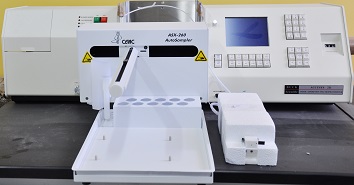Atomic absorption spectrophotometer
تاريخ النشر : 0000-00-00 00:00:00
عدد المشاهدات : 140

تاريخ النشر : 0000-00-00 00:00:00
عدد المشاهدات : 140

Atomic absorption spectrophotometer(Accusys211)
is a spectroanalytical procedure for the quantitative determination of chemical elements using the absorption of optical radiation (light) by free atoms in the gaseous state. It can be used to determine over 70 different elements in solution used in pharmacology, biophysics and toxicology research.
The technique makes use of absorption spectrometry to assess the concentration of an analyte in a sample. It requires standards with known analyte content to establish the relation between the measured absorbance and the analyte concentration and relies therefore on the Beer-Lambert Law. The electrons of the atoms in the atomizer can be promoted to higher orbitals (excited state) for a short period of time (nanoseconds) by absorbing a defined quantity of energy. This amount of energy, i.e., wavelength, is specific to a particular electron transition in a particular element. In general, each wavelength corresponds to only one element, and the width of an absorption line is only of the order of a few picometers (pm), which gives the technique its elemental selectivity. The radiation flux without a sample and with a sample in the atomizer is measured using a detector, and the ratio between the two values (the absorbance) is converted to analyte concentration or mass using the Beer-Lambert Law.
يستخدم لقياس العناصر في الدم وسوائل الجسم وكذلك يستخدم لقياس العناصر في الانسجة بعد هضمها وكذلك يستخدم لمعرفة درجة سمية بعض العناصر من ضمنها يدخل في قياس درجة نقاوة المياه